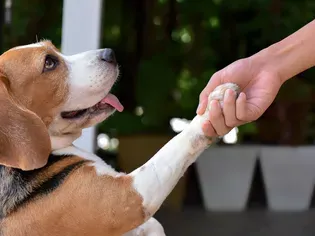How to Use Positive Reinforcement to Train Your Dog
Updated on 04/26/24

Unleashing the Power of Positive Reinforcement: A Guide to Effective Dog Training
In the realm of dog training, positive reinforcement reigns supreme as the most effective and humane approach to shaping desirable behaviors. By harnessing the power of rewards, we can motivate our furry companions to learn and cooperate with unwavering enthusiasm.
Embark on this comprehensive guide to master the art of positive reinforcement and transform your dog into a well-behaved and happy pup.
The Science Behind Positive Reinforcement
Positive reinforcement operates on the principle of operant conditioning, where behaviors that are rewarded are more likely to be repeated. When a dog performs a desired action, such as sitting or staying, you provide a positive reinforcer, which could be a treat, a game of fetch, or verbal praise. This reinforcement strengthens the association between the behavior and the reward, increasing the likelihood of the dog repeating that behavior in the future.
In contrast to punishment-based training methods, positive reinforcement focuses on rewarding desirable behaviors rather than punishing undesirable ones. This approach fosters a positive and harmonious relationship between dog and owner, promoting trust and cooperation.
Types of Positive Reinforcers
The key to successful positive reinforcement is selecting the rewards that your dog finds most motivating. Different dogs may prefer different types of reinforcers, so experimentation is key. Some commonly used positive reinforcers include:
- Food treats: High-value treats such as small pieces of meat, cheese, or liver are often effective motivators for dogs.
- Toys: Interactive toys, such as balls or tug ropes, can also be used as reinforcers for dogs who enjoy playing.
- Praise: Dogs crave attention and affection from their owners. Verbal praise, petting, or a gentle pat on the head can be powerful reinforcers for some dogs.
- Activities: Activities that your dog enjoys, such as a walk, a game of fetch, or a cuddle session, can also be used as rewards.
Examples of Positive Reinforcement in Dog Training
To illustrate the power of positive reinforcement, let's explore some practical examples:
- Teaching "Sit": When your dog sits on command, immediately reward them with a treat or a word of praise. This reinforces the desired behavior and encourages the dog to sit more frequently in the future.
- Curbing Jumping: If your dog jumps up on people, avoid scolding or pushing them away. Instead, redirect their attention with a treat or a toy and reward them when they keep all four paws on the ground. This teaches the dog that jumping is not a desirable behavior.
- Housetraining: When your dog eliminates in the appropriate spot, praise them profusely and give them a treat. This makes the desired behavior more rewarding and increases the likelihood of them choosing the correct elimination spot in the future.
Tips for Effective Positive Reinforcement
To maximize the effectiveness of positive reinforcement, follow these guidelines:
- Consistency is key: Ensure that you reward your dog consistently for desired behaviors. The more predictable the rewards, the more quickly your dog will learn.
- Use high-value reinforcers: The more valuable the reward, the more motivated your dog will be to perform the desired behavior.
- Reward immediately: Reinforce the behavior as soon as it occurs. This creates a strong association between the behavior and the reward.
- Avoid over-rewarding: While it is important to be consistent, avoid giving too many rewards for the same behavior. This can lead to your dog becoming less motivated.
- Be patient and positive: Training your dog takes time and patience. Stay positive during the training process and focus on rewarding your dog for progress, rather than perfection.
Positive reinforcement is not just a technique for shaping behaviors; it is a philosophy that fosters a positive and enriching bond between dog and owner. By harnessing the power of rewards, you can unlock your dog's potential, creating a happy and well-behaved companion for years to come.
Explore More Pets

Basic Training
Puppy and Baby Introductions

Working Dog Breeds
All About Search and Rescue Dogs

Dog Treatments
Puppy Vaginitis: Signs, Causes and Treatment

Dog Adoption
After More Than 1,200 Days in the Shelter, Coco Goes Home

Basic Training
How to Train Your Puppy to Go on Potty Pads

Hybrid Dog Breeds
The Difference Between a Mutt, Mixed Breed, or Designer Dog?

Dog Treatments
Nail Problems in Dogs

Puppies
7 Reasons Why Two Dogs Are Better Than One